
75% vlna, 25% polyamid
od 65.00 Kč /50g
Objednat DROPS Fabel z obchodu Ganella

|
DROPS Fabel uni colour 75% vlna, 25% polyamid |
65.00 Kč /50g |
Objednat |

|
DROPS Fabel 75% vlna, 25% polyamid |
70.00 Kč /50g |
Objednat |

|
DROPS Fabel long print 75% vlna, 25% polyamid |
75.00 Kč /50g |
Objednat |
Kliknutím na OBJEDNAT budete přesměrováni do obchodu Ganella
Cenu za klubka počítáme podle spotřeby při výrobě modelu v nejmenší velikosti a nejlevnější variantě příze. Rádi byste ještě lepší cenu? Třeba ji najdete mezi DROPS Deals!
Queen of Hearts
Souprava: čepice a rukavice – palčáky se srdíčky pletené z příze DROPS Fabel.
DROPS design: model fa-383
Skupina přízí A
----------------------------------------------------------
Na celou soupravu je potřeba asi 100 g příze Fabel v barvě č. 400, černé a 100 g v barvě č. 916, grand canyon.
----------------------------------------------------------
ČEPICE:
Velikost: S/M - M/L
Obvod hlavy: 54/56 - 56/58 cm
Materiál:
DROPS FABEL firmy Garnstudio (spadá do skupiny přízí A)
50-50 g, barva č.400, černá
50-50 g, barva č.916, grand canyon
Použitou přízi můžete také nahradit některou ze seznamu:
"Náhradní příze (Skupina přízí A)" – viz link níže.
DROPS PONOŽKOVÉ JEHLICE a krátká KRUHOVÁ JEHLICE (40 cm) č.2,5 – nebo velikosti potřebné k upletení zkušebního vzorku o rozměrech 26 ok a 34 řad lícovým žerzejem = 10 cm na šířku a 10 cm na výšku.
DROPS krátká KRUHOVÁ JEHLICE (40 cm) č.2 na lem – nebo velikosti potřebné k upletení zkušebního vzorku o rozměrech 29 ok a 38 řad lícovým žerzejem = 10 cm na šířku a 10 cm na výšku.
----------------------------------------------------------
RUKAVICE - PALČÁKY:
Velikost: jednotná
Materiál:
DROPS FABEL firmy Garnstudio (spadá do skupiny přízí A)
50 g, barva č.400, černá
50 g, barva č.916, grand canyon
Použitou přízi můžete také nahradit některou ze seznamu:
"Náhradní příze (Skupina přízí A)" – viz link níže.
DROPS PONOŽKOVÉ JEHLICE č.2,5 – nebo velikosti potřebné k upletení zkušebního vzorku o rozměrech 26 ok a 34 řad lícovým žerzejem = 10 cm na šířku a 10 cm na výšku.
DROPS PONOŽKOVÉ JEHLICE č.2 na lemy – nebo velikosti potřebné k upletení zkušebního vzorku o rozměrech 29 ok a 38 řad lícovým žerzejem = 10 cm na šířku a 10 cm na výšku.
----------------------------------------------------------
-------------------------------------------------------
Náhradní příze – Podívejte se, jak změnit přízi
Skupina přízí A až F – Neměňte návod, změňte přízi
Spotřeba příze při použití náhradní příze – Využijte náš převodník
-------------------------------------------------------

75% vlna, 25% polyamid
od 65.00 Kč /50g
Objednat DROPS Fabel z obchodu Ganella

|
DROPS Fabel uni colour 75% vlna, 25% polyamid 65.00 Kč /50g Objednat |

|
DROPS Fabel print 75% vlna, 25% polyamid 70.00 Kč /50g Objednat |

|
DROPS Fabel long print 75% vlna, 25% polyamid 75.00 Kč /50g Objednat |
Kliknutím na OBJEDNAT budete přesměrováni do obchodu Ganella
Cenu za klubka počítáme podle spotřeby při výrobě modelu v nejmenší velikosti a nejlevnější variantě příze. Rádi byste ještě lepší cenu? Třeba ji najdete mezi DROPS Deals!
- Česky
- Dansk
- Deutsch
- Eesti keel
- English (UK/cm)
- English (US/in)
- Español
- Français
- Íslenska
- Italiano
- Magyar
- Nederlands
- Norsk
- Polski
- Português
- Suomi
- Svenska
- English (UK/cm), Bulgaria
- English (UK/cm), Croatia
- English (UK/cm), Greece
- English (UK/cm), Latvia
- English (UK/cm), Lithuania
- English (UK/cm), Romania
- English (UK/cm), Slovenia
- Česky, Slovakia
Návod
Abychom zabránili vzniku velké dírky uprostřed pleteniny, začínáme touto stahovací smyčkou – je pohyblivá a tak díky ní můžeme velikost dírky upravit:
uchopíme konec příze a obtočíme ji kolem ukazováku levé ruky (zleva doprava), čímž vytvoříme smyčku. Smyčku stáhneme z prstu a podržíme ji palcem a ukazovákem levé ruky. Pak do smyčky vsuneme jehlici, nabereme přízi a protáhneme ji smyčkou (= na jehlici nám vznikne oko), 1x nahodíme (přízi vedeme zezadu dopředu přes jehlici) a nahození protáhneme okem na jehlici, *jehlici vpíchneme do smyčky, nabereme přízi a protáhneme ji smyčkou (= na jehlici nám vznikne oko), 1x nahodíme (přízi vedeme zezadu dopředu přes jehlici) a nahození protáhneme novým okem na jehlici*, *-* opakujeme až do chvíle, kdy máme na jehlici 8 ok. Oka rozdělíme na 4 ponožkové jehlice č.2,5 a pleteme dle popisu v návodu. SOUČASNĚ zatáhneme za konec příze a smyčku stáhneme.
VZOR:
Viz schémata A.1 až A.5 – zobrazeny jsou všechny řady vzoru nahlížené z lícové strany. U schémat A.1 a A.2 si zvolte schéma pro požadovanou velikost.
----------------------------------------------------------
ČEPICE:
Pleteme v kruhových řadách na kruhové jehlici, s ubývajícím počtem ok převedeme pleteninu na ponožkové jehlice.
Na krátkou kruhovou jehlici č.2 nahodíme černou přízí 128-152 ok a upleteme 1 kruhovou řadu hladce. V následující kruhové řadě začneme plést lem pružným vzorem 2/2, tj. střídáme 2 oka hladce, 2 obrace. Ve výši asi 4 cm převedeme pleteninu na krátkou kruhovou jehlici č.2,5. Pleteme 1 kruhovou řadu hladce a SOUČASNĚ ujmeme rovnoměrně 8 ok = 120-144 ok. Pleteme vzor A.1 (počet ok ve vzoru je dělitelný 8, ale jelikož by schémata měla navazovat jedno na druhé – nad sebou – musíme začít v různých místech vzoru, podle jednotlivých velikostí). Sekvenci vzoru A.1 pleteme v kruhové řadě celkem 3-6x. Když dokončíme 3 celé sekvence vzoru (na výšku), měří díl asi 17 cm. Pak pleteme namísto vzoru A.1 vzor A.2. Po dokončení celé sekvence vzour (na výšku) zbývá na jehlici 12 ok. Všechna oka spleteme po 2 dohromady = 6 ok. Přízi odstřihneme, několikrát protáhneme zbylými oky, stáhneme a zapošijeme.
----------------------------------------------------------
RUKAVICE - PALČÁKY:
Pleteme v kruhových řadách na ponožkových jehlicích. Začneme špičkou a postupujeme od prstů přes dlaň ke klínu pro palec. Palec upleteme v kruhových řadách také shora ještě před tím, než začneme tvarovat klín, a oba díly pak spojíme dohromady. Dál pleteme v kruhových řadách.
RUKAVICE - 1. ČÁST:
Začínáme černou přízí a STAHOVACÍ SMYČKOU – viz výše = 8 ok rozdělíme na 4 ponožkové jehlice č.2,5 – POZN.: pokud nechcete začínat stahovací smyčkou, nahoďte černou přízí 8 ok (po dokončení rukavice pak provlečte konec příze oky počáteční, nahozené řady, stáhněte je a přízi zapošijte).
Pleteme v kruhových řadách vzor A.3 pro levou rukavici a vzor A.4 pro pravou rukavici. Když je dokončeno přidávání podle schématu, máme v kruhové řadě 56 ok. Pokračujeme v pletení až ke kruhové řadě označené ve schématu šipkou (díl měří asi 12 od špičky) – v této kruhové řadě uzavřeme 3 oka pro klín pro palec (= černé čtverečky ve schématu). Díl odložíme a upleteme palec.
PALEC:
Začínáme černou přízí a STAHOVACÍ SMYČKOU = 8 ok rozdělíme na 4 ponožkové jehlice č.2,5. Pleteme v kruhových řadách podle schématu A.5. Když je dokončeno přidávání podle schématu, máme v kruhové řadě 20 ok. V poslední kruhové řadě schématu uzavřeme pro klín 3 oka (= černé čtverečky ve schématu) = zbývá 17 ok palce.
RUKAVICE - 2. ČÁST:
Palec teď spojíme s rukavicí – oba díly převedeme na společné jehlice, palec umístíme tam, kde jsou uzavřená oka pro klín. Pokračujeme v kruhových řadách vzorem A.3/A.4 jako dříve, černé čtverečky ve schématech přeskočíme – namísto nich pleteme vzor A.6 (= klín pro palec). Hvězdička ve schématu A.6 musí být zarovnaná s hvězdičkou ve schématu A.5, aby vzor správně navazoval. Po dokončení celé sekvence vzoru A.6 (na výšku) máme v kruhové řadě 56 ok. Pokračujeme vzorem A.3/A.4. Po dokončení celé sekvence vzorů převedeme pleteninu na ponožkové jehlice č.2 upleteme 1 kruhovou řadu hladce. Pak upleteme 5 kruhových řad pružným vzorem 2/2 a poté všechna oka dle vzoru uzavřeme.
Sešijeme otvor pro palec. Přízi odstřihneme a zapošijeme.
Schéma

|
= černá |

|
= grand canyon |

|
= 1x nahodíme mezi 2 oky; v následující kruhové řadě pleteme nahození za zadní nit, aby se v pletenině netvořily dírky |

|
= 2 oka spleteme hladce černou |

|
= 1 oko sejmeme hladce, 1 upleteme hladce černou a sejmuté přes ně přetáhneme |

|
= 1 oko sejmeme hladce, 2 oka spleteme hladce a sejmuté přes ně přetáhneme |

|
= oko uzavřené ve vzoru A.3, A.4 a A.5; čtvereček přeskočíme |

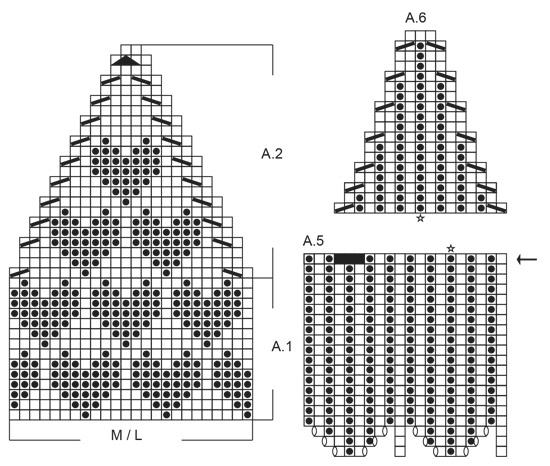

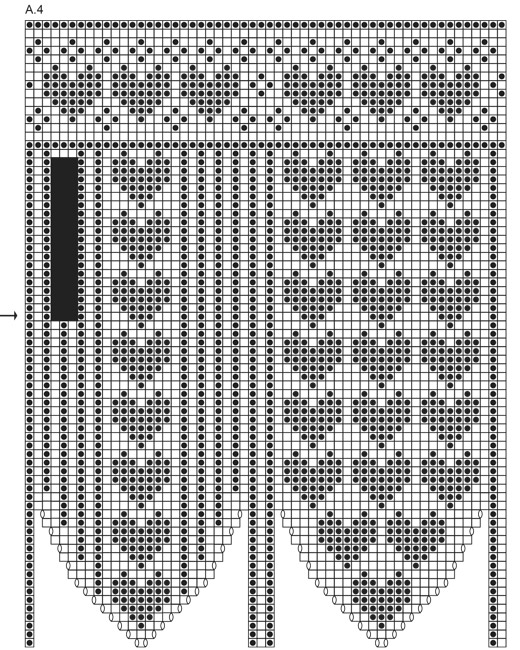
Jak můžete zacházet s našimi návody? Můžete sdílet DROPS návody online, s použitím původní fotky, uvedením originální příze, jména a čísla modelu. Ale JE ZAKÁZÁNO jakkoli reprodukovat či kopírovat celé návody v digitální podobě. Obchody s přízí mohou využívat databázi DROPS návodů k podpoře prodeje našich produktů. Návody si můžete vytisknout v libovolném počtu kopií. Žádáme vás o jedinou věc: nedělejte žádné úpravy a změny v tištěném originálu, ani původní návod v tištěné podobě nijak nedoplňujte. A také respektujte pravidlo DROPS a návody poskytujte klientům zdarma. Vydavatele, kteří by rádi zveřejnili naše návody v tištěných knihách nebo časopisech, prosíme, aby nás kontaktovali - rádi jim poskytneme podrobnější informace. Prodej výrobků vytvořených podle návodů DROPS je povolen pouze v případě, že jde o prodej jednotlivých kusů nebo výrobu na zakázku. Větší komerční využití návodů dovoleno není. U každého výrobku musí být rovněž jasně a zřetelně uvedeno, že jde o výrobek podle modelu z kolekce DROPS DESIGN. Opatřit nášivkami či visačkami oděvy, které využívají DROPS DESIGN je podmíněno uvedením následujícího textu: "Model DROPS DESIGN vytvořil/a...(doplňte jméno člověka, který oděv vyrobil)". Použití fotografií DROPS pro marketingové účely/prodej je povoleno výhradně v přímé souvislosti s použitím/prodejem přízí, pomůcek a doplňků DROPS. Fotografie nesmí být vystřižené, ořezané ani jinak upravené a logo na nich musí zůstat zřetelně viditelné.
Vyhrazujeme si právo kdykoli stáhnout povolení k užívání, a to bez udání důvodu.
Každý náš návod je doprovázen speciálními video-ukázkami, které vás navedou.
Tyto podrobné video-návody vás povedou "krok za krokem":
Proč je napětí příze u pletení/ háčkování tak důležité?
Napětí příze (hustota úpletu) určuje konečné míry vaší práce a obvykle se měří na vzorku 10 x 10 cm. Spočítáme takto: počet ok na šířku x počet řad na výšku - např.: 19 ok x 26 řad = 10 x 10 cm.
Napětí příze je velmi individuální; někteří lidé pletou/ háčkují volně, zatímco jiní značně utahují. Napětí příze přizpůsobíte změnou velikosti jehlic, proto doporučenou velikost jehlic berte pouze jako vodítko! Je důležité, abyste zajistili, že VAŠE napětí příze odpovídá napětí uvedenému ve vzoru. Pokud budete pracovat s jiným napětím příze než je uvedeno ve vzoru, vaše spotřeba příze a konečné rozměry vaší práce se budou lišit.
Napětí příze také určuje, které příze je možné vzájemně zaměňovat. Pokud dosáhnete stejného napětí příze, můžete snadno zaměnit jednu přízi za druhou.
Viz lekce DROPS: Jak změřit napětí příze/ zkušební vzorek
Viz video DROPS: Jak vypracovat zkušební vzorek napětí příze
Jak zjistím, kolik klubek příze potřebuji?
Požadované množství příze je uvedeno v gramech, např.: 450 g. Pro výpočet potřebného množství klubek musíte nejdříve vědět, kolik gramů je v 1 klubku (25 g, 50 g nebo 100 g). Tyto informace jsou dostupné po kliknutí na jednotlivé druhy přízí na našich stránkách. Vydělte požadované množství množstvím každého klubka. Pokud má například klubko 50 g (nejběžnější množství), výpočet bude následující: 450 / 50 = 9 klubek.
Mohu použít jinou přízi než jaká je doporučena u vybraného vzoru?
Při záměně jedné příze za druhou je důležité, aby napětí příze (hustota úpletu) při pletení/ háčkování zůstala stejná. To proto, aby rozměry hotového oděvu odpovídaly poskytnutému náčrtu. Stejného napětí příze je snazší dosáhnout pomocí přízí ze stejné skupiny. Je také možné pracovat s vícero vlákny tenčí příze najednou, a tak dosáhnout stejného napětí jako při práci se silnější přízí. Vyzkoušejte náš převodník přízí. Doporučujeme vám si vždy vypracovat zkušební vzorek (swatch).
POZNÁMKA: při záměně přízí se může oděv výrazně lišit od oděvu na fotografii, to díky rozdílným vlastnostem a složení každé příze.
Viz lekce DROPS: Mohu použít jinou přízi než je uvedena ve vzoru?
Co to jsou skupiny přízí DROPS?
Všechny naše příze jsou rozděleny do skupin přízí (od A do F) podle síly a napětí příze – skupina A zahrnuje nejtenčí příze a skupina F ty nejsilnější. Toto vám usnadní hledání alternativních přízí k našim vzorům, pokud byste chtěli přízi vyměnit. Všechny příze stejné skupiny mají podobné napětí příze (hustotu úpletu) a můžete je tak snadno vzájemně nahrazovat. Jednotlivé druhy přízí se nicméně liší složením a vlastnostmi, hotové dílo tak získá na jedinečnosti jak na pohled tak na omak.
Kliknutím zde zobrazíte přehled přízí v jednotlivých skupinách.
Jak použít převodník přízí (yarn calculator)?
V horní části všech našich vzorů najdete odkaz na náš převodník přízí (yarn calculator), což je užitečný nástroj, pokud byste chtěli použít jinou než doporučenou přízi. Vyplněním druhu příze, kterou si přejete vyměnit, množství (ve vaší velikosti) a počtu vláken, vám převodník nabídne vhodné alternativní příze se stejným napětím příze (hustotou úpletu). Dále vám prozradí, kolik alternativní příze budete potřebovat a zda budete muset pracovat s vícero vlákny najednou. Většina klubek má hmotnost 50 g (některá 25 g nebo 100 g).
Pokud je vzor vypracován ve vícero barvách najednou, bude nutné každou barvu vypočítat samostatně. Stejně tak, pokud je vzor vypracován s několika vlákny různých přízí (například 1 vlákno alpaky a 1 vlákno Kid-Silk), budete muset najít alternativy jednotlivě, tedy pro každou zvlášť.
Kliknutím zde zobrazíte náš převodník přízí
Proč u vzorů stále uvádíte příze, které se již nevyrábí?
Protože různé příze mají různé vlastnosti a textury, rozhodli jsme se původní přízi v našich vzorech zachovat. Můžete však snadno najít dostupné alternativy mezi našimi ostatními druhy přízí pomocí našeho převodníku nebo si jednoduše vybrat přízi ze stejné skupiny přízí.
Je možné, že někteří prodejci mají přízi stále na skladě, nebo že někdo má doma pár klubek, pro která by rád našel vzory.
Převodník přízí vám nabídne jak alternativní přízi, tak i její požadované množství.
Jakou mám zvolit velikost?
Pokud si nejste jistí jakou velikost vypracovat, můžete například změřit oděv, který již vlastníte a jehož velikost se vám líbí. Následně si zvolte velikost porovnáním těchto mír s těmi v tabulce velikostí vybraného vzoru.
Tabulku velikostí najdete ve spodní části vzoru.
Viz lekce DROPS: Jak číst tabulku velikostí
Proč mi nevychází velikost zkušebního vzorku na doporučené síle jehlic?
Velikost jehlic uvedená ve vzoru slouží pouze jako vodítko, důležité je dodržet napětí příze (hustotu úpletu). A protože napětí příze je velmi individuální, budete muset upravit velikost jehlic tak, abyste zajistili stejné napětí jaké je uvedené ve vzoru – možná budete muset přizpůsobit sílu jehlic o 1 či dokonce 2 velikosti abyste dosáhli správného napětí. Za tímto účelem vám doporučujeme vypracovat zkušební vzorky.
Pokud byste pracovali s jiným napětím příze než je uvedeno, rozměry hotového oděvu se mohou od rozměrů uvedených na náčrtu lišit.
Viz lekce DROPS: Jak změřit napětí příze/ zkušební vzorek
Viz video DROPS: Jak vypracovat zkušební vzorek
Proč je vzor vypracován shora dolů?
Práce s oděvem shora dolů poskytuje větší flexibilitu a prostor pro individuální úpravy. Například je snazší si oděv v průběhu práce vyzkoušet a také upravit délku sedla a průramků.
Návody vše pečlivě vysvětlují krok za krokem, ve správném pořadí. Schémata jsou přizpůsobena směru pletení a vypracována jako obvykle.
Jak správně číst schéma u pletení?
Schéma zobrazuje všechny řady/ kruhové řady, a každé oko jak se jeví při pohledu z lícové strany. Čte se zdola nahoru, zprava doleva. 1 čtvereček = 1 oko.
Při práci v řadách (tam a zpět) je každá lichá řada řadou lícovou a každá sudá řada je řadou rubovou. Při práci v rubových řadách je nutné vypracovávat schéma obráceně: zleva doprava, hladká oka pleteme obrace, oka pletená obrace vypleteme hladce atd.
Při práci v kruhových řadách je každá řada řadou lícovou a schéma je tedy ve všech řadách vypracováno zprava doleva.
Viz lekce DROPS: Jak číst schémata u pletení
Jak správně číst schéma u háčkování?
Schéma zobrazuje všechny řady/ kruhové řady, a každé oko jak se jeví při pohledu z lícové strany. Vypracovává se zdola nahoru, zprava doleva.
Při práci v řadách (tam a zpět) je každá lichá řada řadou lícovou a každá sudá řada je řadou rubovou. Při práci v rubových řadách je nutné vypracovávat schéma obráceně: zleva doprava.
Při práci v kruhových řadách je každá řada řadou lícovou a schéma je tedy ve všech řadách vypracováno zprava doleva.
Při práci s kruhovým schématem začínáme uprostřed a postupujeme směrem proti směru hodinových ručiček, řadu po řadě.
Řady obvykle začínají daným počtem řetízkových ok (ekvivalentní výšce následujícího oka), což bude buď znázorněno ve schématu nebo vysvětleno ve vzoru.
Viz lekce DROPS: Jak číst schémata u háčkování
Jak vypracovat několik schémat zároveň v jedné řadě/ kruhové řadě?
Pokyny pro práci s vícero schématy zároveň ve stejné řadě/kruhové řadě budou často popsány takto: „háčkujeme vzor A.1, A.2, A.3 celkem 0-0-2-3-4x". To znamená, že A.1 vypracujete jednou, následně A.2 vypracujete jednou a A.3 opakujete (na šířku) tolikrát, kolikrát je pro vaši velikost stanoveno – v tomto případě takto: S = 0 krát, M = 0 krát, L=2 krát, XL= 3 krát a XXL = 4 krát.
Se schématy se pracuje jako obvykle: začněte první řadou v A.1, poté vypracujte první řadu v A.2 atd.
Viz lekce DROPS: Jak číst schémata u pletení
Viz lekci DROPS: Jak číst schémata u háčkování
Proč jsou rukávy u větších velikostí kratší?
Celková šířka oděvu (od zápěstí k zápěstí) bude u větších velikostí větší, přestože rukávy jsou kratší. Větší velikosti mají delší průramky a širší náramenice, aby dobře seděly pro všechny velikostech.
Odkud měřím délku oděvu?
Rozměry na náčrtu/ schématu poskytují informace k celkové délce oděvu. Pokud se jedná o svetr nebo kabátek, délka se měří od nejvyššího bodu na náramenici nejblíže výstřihu směrem dolů ke spodní části oděvu. NENÍ měřeno od vrcholu ramene. Stejně se měří i délka sedla, od nejvyššího bodu náramenice dolů k místu, kde se sedlo dělí na trup a rukávy.
U kabátků, pokud není výslovně uvedeno jinak, se nikdy neměří délka na vnější straně légy. Vždy měřte délku na vnitřní straně.
Viz lekce DROPS: Jak číst schéma
Co znamená opakování?
Schémata se často opakují dokola nebo na výšku. 1 opakování na schématu tak, jak se jeví ve vzoru. Pokud je uvedeno vypracujte 5 opakování A.1 v řadě, pak vypracujete A.1 celkem 5 krát po sobě/ vedle sebe v jedné řadě. Pokud je uvedeno vypracujte 2 opakování A.1 svisle/ na výšku, vypracujte celé schéma jednou, následně začněte znovu od počátku následující řady a vypracujte celé schéma ještě jednou.
Proč je počet počátečních nahozených ok vyšší než počet, s kterým dále pracujeme?
Řetízková oka jsou o něco užší než sloupky. Abyste předešli příliš staženým okům nahozeného okraje, jednoduše uháčkujte více ok řetízku. Počet ok bude v následující řádě upraven tak, aby odpovídal vzoru a náčrtu.
Proč při práci shora dolů přidáváme oka pro pružný lem?
Pružný lem se oproti například lícovému žerzeji jeví mnohem staženější. Přidáním ok před vypracováním lemu se vyhnete viditelnému rozdílu v šířce přechodu mezi pružným lemem a zbytkem trupu.
Proč před uzavíráním lemu přidáváme oka?
Je snadné uzavřít lem příliš pevně. Nahazováním ok při uzavírání lemu (a současným uzavíráním těchto nahození) předejdete příliš utaženému okraji.
Viz video DROPS: Jak uzavřít pomocí nahození (yo)
Jak střídavě ujmout/ přidat v každé 3. a 4. řadě/ kruhové řadě?
Pro dosažení rovnoměrného přidání (nebo ujmutí) můžete přidat např.: každou 3. a 4. řadu střídavě takto: vypracujte 2 řady a přidejte v 3. řadě, vypracujte 3 řady a přidejte ve 4. Takto opakujte až po poslední přidávání..
Viz lekce DROPS: Přidávání či ujímání 1 oka střídavě v každé 3. a 4. řadě
Jak vypracuji kabátek v kruhových řadách namísto v řadách (tam a zpět)?
Pokud dáváte přednost práci v kruhových řadách namísto v řadách (tam a zpět), můžete samozřejmě vzor přizpůsobit a to tak, že přidáte můstky doprostřed přední části (obvykle 5 ok). Dále pak postupujete podle pokynů. Kde byste normálně otočili práci a pracovali z rubové strany, jednoduše pokračujete dál přes můstek v kruhových řadách. Nakonec kabátek rozstřihnete, naberete stehy pro vypracování légy a zakryjete rozstřižené okraje.
Viz video DROPS: Jak uplést a rozstřihnout můstek
Mohu vypracovat svetr v řadách (tam a zpět) namísto v kruhových řadách?
Pokud dáváte přednost práci v řadách (tam a zpět) namísto v kruhových řadách, můžete samozřejmě vzor přizpůsobit a to tak, že jednotlivé díly vypracujete samostatně a na konci je sešijete dohromady. Rozdělte počet ok trupu na polovinu, přidejte na každé straně 1 krajové oko (pro sešití) a vypracujte přední a zadní díl odděleně.
Viz lekce DROPS: Mohu vzor na kruhových jehlicích přizpůsobit rovným jehlicím?
Proč se popis vzoru mírně liší od modelu na fotografii?
Aby se zachovaly správné proporce, opakování vzoru se může v různých velikostech mírně lišit. Pokud nepracujete se stejnou velikostí v jaké je i oděv na fotografii, může se ten váš mírně lišit. Vzor byl pečlivě navržen a upraven tak, aby celkový dojem z oděvu zůstal stejný ve všech velikostech.
Dodržujte proto pokyny a schémata pro vaši velikost!
Jak změním oděv z dámské velikosti na pánskou?
Pokud jste našli vzor, který se vám líbí a který je k dispozici v dámské velikosti, není příliš těžké jej přizpůsobit velikosti pánské. Největší rozdíl bude v délce rukávů a trupu. Začněte pracovat na dámské velikosti o které si myslíte, že by seděla přes hrudník. Dodatečná délka bude vypracována těsně před uzavřením pro průramky. Pokud je vzor vypracován shora dolů, můžete přidat délku hned za průramky nebo před prvním ujmutím na rukávu.
Pokud jde o dodatečné množství příze, bude záležet na přidané délce, ale je lepší mít více klubek než-li méně.
Jak předejít línání u chlupatého oděvu?
Všechny příze mají přebytečná vlákna (z výroby), která mohou žmolkovat či odpadat. Česané příze (tj. chlupatější příze) mají více těchto volných, nadbytečných vláken, což způsobuje větší línání.
Línání také závisí na tom, co nosíme pod nebo přes oděv a zda to táhne vlákna příze. Není proto možné zaručit, že nedojde k žádnému línání
Níže je několik tipů, jak dosáhnout nejlepších výsledků při práci s chlupatější přízí:
1. Když je oděv hotový (než ho vyperete), silně s ním protřepejte, aby se volnější chloupky uvolnily. POZNÁMKA: NEPOUŽÍVEJTE čistící váleček na textil, kartáč ani jinou metodu, která tahá za přízi.
2. Oděv vložte do plastového sáčku a vložte jej do mrazáku – nízká teplota způsobí, že se vlákna k sobě méně přichytí a přebytečná vlákna se snadněji odloučí.
3. Ponechte několik hodin v mrazáku, než jej vyjmete a znovu protřepete.
4. Oděv perte podle pokynů na štítku příze.
Proč se na mé pletenině tvoří žmolky?
Žmolkování je přirozený proces, ke kterému dochází i u těch nejexkluzivnějších vláken. Je to přirozená známka opotřebení, kterému jde jen těžko předejít. Opotřebení je nejviditelnější v místech s vysokým třením, jako je podpaží či lemy.
Váš oděv může vypadat opět jako nový, když žmolky odstraníte pomocí kartáče na šaty nebo speciálního strojku - odžmolkovače.
Mezitím si můžete pročíst otázky a odpovědi, které k tomuto modelu položili ostatní, nebo navštívit skupinu DROPS Workshop na Facebooku, kde vám může poradit některá spřízněná duše!
Mohly by se vám líbit...
Queen of Hearts
Queen of Hearts
Queen of Hearts |
||||||||||||||||||||||
 |
 |
|||||||||||||||||||||
Souprava: čepice a rukavice – palčáky se srdíčky pletené z příze DROPS Fabel.
DROPS 183-23 |
||||||||||||||||||||||
|
STAHOVACÍ SMYČKA, KOUZELNÝ KROUŽEK: Abychom zabránili vzniku velké dírky uprostřed pleteniny, začínáme touto stahovací smyčkou – je pohyblivá a tak díky ní můžeme velikost dírky upravit: uchopíme konec příze a obtočíme ji kolem ukazováku levé ruky (zleva doprava), čímž vytvoříme smyčku. Smyčku stáhneme z prstu a podržíme ji palcem a ukazovákem levé ruky. Pak do smyčky vsuneme jehlici, nabereme přízi a protáhneme ji smyčkou (= na jehlici nám vznikne oko), 1x nahodíme (přízi vedeme zezadu dopředu přes jehlici) a nahození protáhneme okem na jehlici, *jehlici vpíchneme do smyčky, nabereme přízi a protáhneme ji smyčkou (= na jehlici nám vznikne oko), 1x nahodíme (přízi vedeme zezadu dopředu přes jehlici) a nahození protáhneme novým okem na jehlici*, *-* opakujeme až do chvíle, kdy máme na jehlici 8 ok. Oka rozdělíme na 4 ponožkové jehlice č.2,5 a pleteme dle popisu v návodu. SOUČASNĚ zatáhneme za konec příze a smyčku stáhneme. VZOR: Viz schémata A.1 až A.5 – zobrazeny jsou všechny řady vzoru nahlížené z lícové strany. U schémat A.1 a A.2 si zvolte schéma pro požadovanou velikost. ---------------------------------------------------------- ČEPICE: Pleteme v kruhových řadách na kruhové jehlici, s ubývajícím počtem ok převedeme pleteninu na ponožkové jehlice. Na krátkou kruhovou jehlici č.2 nahodíme černou přízí 128-152 ok a upleteme 1 kruhovou řadu hladce. V následující kruhové řadě začneme plést lem pružným vzorem 2/2, tj. střídáme 2 oka hladce, 2 obrace. Ve výši asi 4 cm převedeme pleteninu na krátkou kruhovou jehlici č.2,5. Pleteme 1 kruhovou řadu hladce a SOUČASNĚ ujmeme rovnoměrně 8 ok = 120-144 ok. Pleteme vzor A.1 (počet ok ve vzoru je dělitelný 8, ale jelikož by schémata měla navazovat jedno na druhé – nad sebou – musíme začít v různých místech vzoru, podle jednotlivých velikostí). Sekvenci vzoru A.1 pleteme v kruhové řadě celkem 3-6x. Když dokončíme 3 celé sekvence vzoru (na výšku), měří díl asi 17 cm. Pak pleteme namísto vzoru A.1 vzor A.2. Po dokončení celé sekvence vzour (na výšku) zbývá na jehlici 12 ok. Všechna oka spleteme po 2 dohromady = 6 ok. Přízi odstřihneme, několikrát protáhneme zbylými oky, stáhneme a zapošijeme. ---------------------------------------------------------- RUKAVICE - PALČÁKY: Pleteme v kruhových řadách na ponožkových jehlicích. Začneme špičkou a postupujeme od prstů přes dlaň ke klínu pro palec. Palec upleteme v kruhových řadách také shora ještě před tím, než začneme tvarovat klín, a oba díly pak spojíme dohromady. Dál pleteme v kruhových řadách. RUKAVICE - 1. ČÁST: Začínáme černou přízí a STAHOVACÍ SMYČKOU – viz výše = 8 ok rozdělíme na 4 ponožkové jehlice č.2,5 – POZN.: pokud nechcete začínat stahovací smyčkou, nahoďte černou přízí 8 ok (po dokončení rukavice pak provlečte konec příze oky počáteční, nahozené řady, stáhněte je a přízi zapošijte). Pleteme v kruhových řadách vzor A.3 pro levou rukavici a vzor A.4 pro pravou rukavici. Když je dokončeno přidávání podle schématu, máme v kruhové řadě 56 ok. Pokračujeme v pletení až ke kruhové řadě označené ve schématu šipkou (díl měří asi 12 od špičky) – v této kruhové řadě uzavřeme 3 oka pro klín pro palec (= černé čtverečky ve schématu). Díl odložíme a upleteme palec. PALEC: Začínáme černou přízí a STAHOVACÍ SMYČKOU = 8 ok rozdělíme na 4 ponožkové jehlice č.2,5. Pleteme v kruhových řadách podle schématu A.5. Když je dokončeno přidávání podle schématu, máme v kruhové řadě 20 ok. V poslední kruhové řadě schématu uzavřeme pro klín 3 oka (= černé čtverečky ve schématu) = zbývá 17 ok palce. RUKAVICE - 2. ČÁST: Palec teď spojíme s rukavicí – oba díly převedeme na společné jehlice, palec umístíme tam, kde jsou uzavřená oka pro klín. Pokračujeme v kruhových řadách vzorem A.3/A.4 jako dříve, černé čtverečky ve schématech přeskočíme – namísto nich pleteme vzor A.6 (= klín pro palec). Hvězdička ve schématu A.6 musí být zarovnaná s hvězdičkou ve schématu A.5, aby vzor správně navazoval. Po dokončení celé sekvence vzoru A.6 (na výšku) máme v kruhové řadě 56 ok. Pokračujeme vzorem A.3/A.4. Po dokončení celé sekvence vzorů převedeme pleteninu na ponožkové jehlice č.2 upleteme 1 kruhovou řadu hladce. Pak upleteme 5 kruhových řad pružným vzorem 2/2 a poté všechna oka dle vzoru uzavřeme. Sešijeme otvor pro palec. Přízi odstřihneme a zapošijeme. |
||||||||||||||||||||||
Vysvětlivky ke schématu |
||||||||||||||||||||||
|
||||||||||||||||||||||

|
||||||||||||||||||||||

|
||||||||||||||||||||||

|
||||||||||||||||||||||

|
||||||||||||||||||||||
|
Vyrobili jste si tento nebo nějaký jiný z našich modelů? Přidejte ke svým fotkám na sociálních sítích tag #dropsdesign - díky tomu je uvidíme i my! Potřebujete s tímto návodem poradit?Otevřete-li si návod na stránce garnstudio.com, najdete tam výukových video-ukázek, Komentáře/Dotazy a další užitečné informace. © 1982-2024 DROPS Design A/S. Vyhrazujeme si veškerá práva. Tento dokument, včetně všech jeho dílčích částí, podléhá autorským právům. Podrobnější komentář k možnostem užití našich návodů najdete dole pod každým návodem na našich stránkách. |
||||||||||||||||||||||
V oblasti pletené a háčkované módy působí DROPS Design více než 40 let. Díky tomu vám můžeme nabídnout jednu z nejrozsáhlejších kolekcí modelů s bezplatnými návody dostupnými na internetu - navíc v 17 jazycích. K dnešnímu dni máme na 304 katalogů a 11422 návodů celkem - z nich je už 6292 dostupných v češtině.







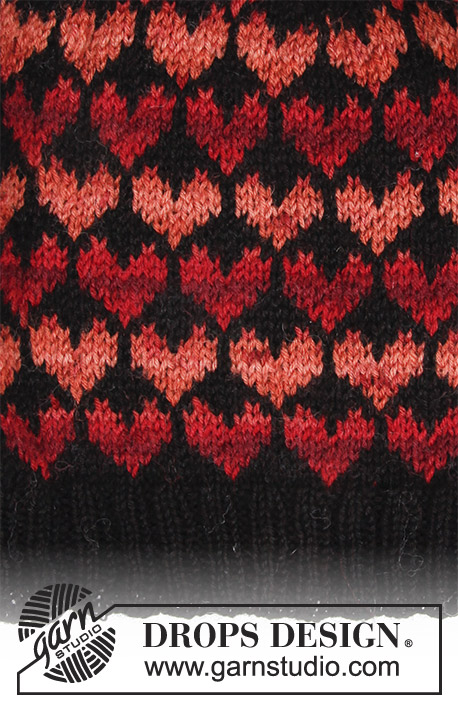

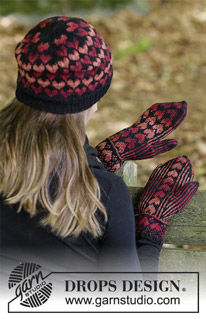

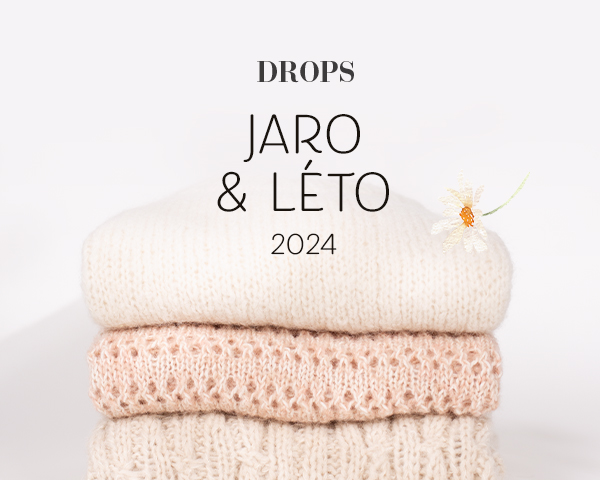


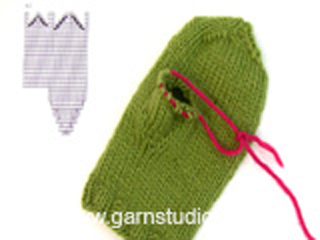






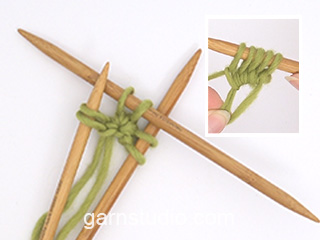




















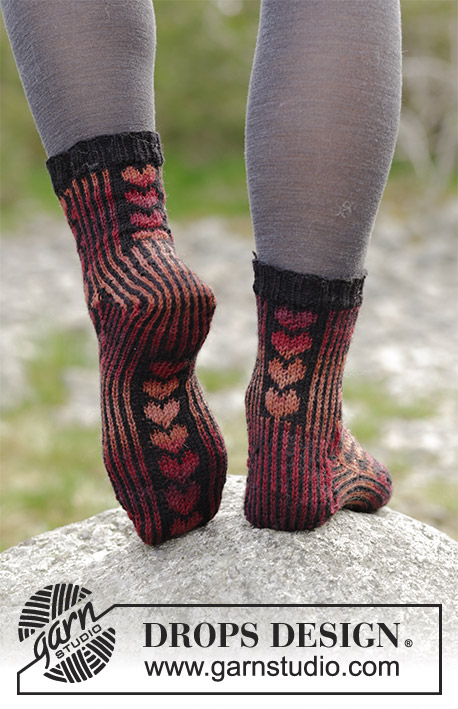






Komentáře / Otázky (23)
Hej, varför krångla till beskrivningen och börja uppifrån. Svårt att förstå hur man lägger till tummen och tumkilen. En video där ni visar detta krångliga sätt att lägga till tummen vore bra. Dessutom blir vanten väldigt liten och smal.
13.03.2023 - 08:09Can I start this pattern from the bottom rather than the top?
20.02.2023 - 17:23DROPS Design answered:
Dear Maree, probably, but you will then have to change all description/explanation to start with the end and read the diagrams top down - knit first a swatch to check if you like the coloured pattern worked from top down. Happy knitting!
21.02.2023 - 09:58I’m still struggling with how to start these mittens. I don’t understand your response So, I’ve got the 8 beginning stitches on my magic loop. What do I do next? Please help step by step or refer me to another source that could help. I appreciate your assistance. Thank you.
14.02.2023 - 05:55DROPS Design answered:
Dear Mrs Gander, read the diagram A.3/A.4 from the bottom corner on the right side towards the left on every round, for ex on first round work: K1 with MC, K1 with CC, (YO, K1, YO) with MC, K1 with CC, K1 with MC, K1 with CC, (YO, K1, YO) with MC, K1 with CC (you have increased 4 sts). Hope it will help. Happy knitting!
14.02.2023 - 14:17I’m starting 183-23. I’ve got the eight stitches on my needles. Now I’m to go to A3 who’s appears to be the bottom of the mitten band which has many more than 8 stitches. What am I supposed to do?
11.02.2023 - 20:43DROPS Design answered:
Dear Karee, there are 8 stitches in the first row of A.3; there is a lot of blank space between the stitches which is represented in this way so that the later rows are better visualized. Start as follows: 1 st in grand canyon, yarn over, 1 st in black, yarn over, 1 st in grand canyon, 1 st in black, 1 st in grand canyon, yarn over, 1 st in black, yarn over, 1 st in grand canyon, 1 st in black. So, you worked over 8 stitches and worked 4 yarn overs. Happy knitting!
12.02.2023 - 20:58Could i use 3,5mm needles and thicker yarn and downsize the stitches?
02.02.2023 - 02:49DROPS Design answered:
Hi Lilian, You will need to downsize the number of stitches (and rows) quite considerable if you both increase the yarn thickness and the needle size. Recommend that you work a swatch and adjust all stitch-numbers before you start working. Good luck and happy knitting!
02.02.2023 - 06:48Pourquoi que le diagramme est séparé en deux dans la grandeur s/m
27.02.2022 - 21:27DROPS Design answered:
Bonjour Mme Guay, lorsque A.1 est terminé, vous tricotez A.2, et vous devez répéter le diagramme A.2 tel qu'indiqué autrement dit, vous diminuez avant les 2 premiers coeurs, après ces 2 coeurs, puis après les 2 suivants, et continuez ainsi en répétant toutes les mailles de A.2 en largeur (ceci pour que les diminutions soient adaptées au jacquard). Bon tricot!
28.02.2022 - 10:34Det er størrelse M/L eg prøved meg på fikk ikkje den til
19.10.2020 - 14:31DROPS Design answered:
Hej Therese, når du kommer til fellingen kan du ikke strikke lige så mange hjerter, efter de 2 hjerter får du 15 masker (mellem hjerterne) som tages ind til 13 masker. Sørg for at spidserne på de 2 hjerter kommer imellem hjerterne på rækken nedenfor. God fornøjelse!
22.10.2020 - 15:14Eg trur oppskriften på luen er ikkje heilt riktige og det.får ikkje heilt til
16.10.2020 - 11:21Eg får ikkje mønster til å stemme på luen
16.10.2020 - 09:16Eg får ikkje mønster til å stemme når eg skal begynne å fellingen
16.10.2020 - 08:46DROPS Design answered:
Hei Therese. Hvilken størrelse strikker du? Når du skal starte med fellingene, 4. omgang av A.2 vil det være ulike sorte masker mellom hvert hjerte. Husk å hake av for "Spørsmål" når du har spørsmål til en oppskrift, hakes det av for "Kommentarer" vil det ikke bli besvart. mvh DROPS design
19.10.2020 - 11:37